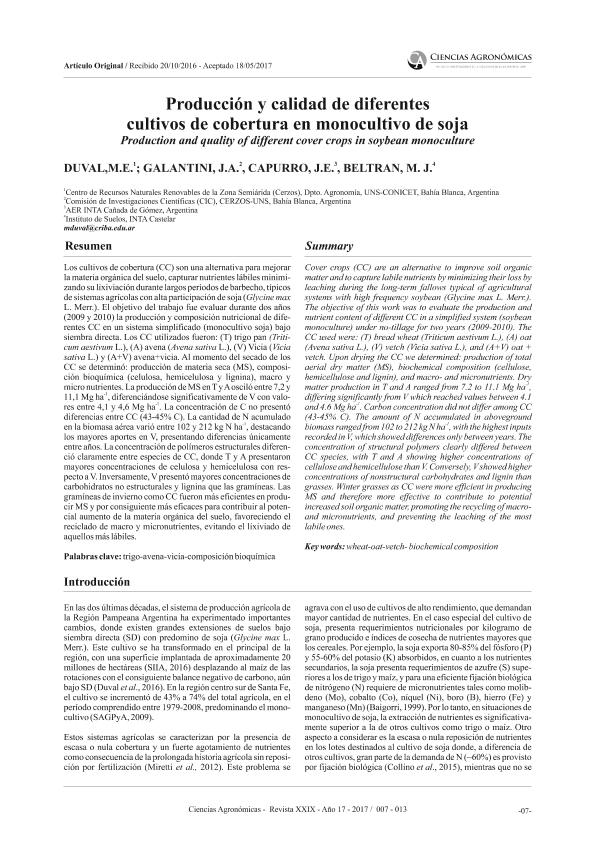Artículo
Los cultivos de cobertura (CC) son una alternativa para mejorar la materia orgánica del suelo, capturar nutrientes lábiles minimizando su lixiviación durante largos períodos de barbecho, típicos de sistemas agrícolas con alta participación de soja (Glycine max L. Merr.). El objetivo del trabajo fue evaluar durante dos años (2009 y 2010) la producción y composición nutricional de diferentes CC en un sistema simplificado (monocultivo soja) bajo siembra directa. Los CC utilizados fueron: (T) trigo pan (Triticum aestivum L.), (A) avena (Avena sativa L.), (V) Vicia (Vicia sativa L.) y (A+V) avena+vicia. Al momento del secado de los CC se determinó: producción de materia seca (MS), composición bioquímica (celulosa, hemicelulosa y lignina), macro y micro nutrientes. La producción de MS en T y A osciló entre 7,2 y 11,1 Mg ha-1, diferenciándose significativamente de V con valores entre 4,1 y 4,6 Mg ha-1. La concentración de C no presentó diferencias entre CC (43-45% C). La cantidad de N acumulado en la biomasa aérea varió entre 102 y 212 kg N ha-1, destacandolos mayores aportes en V, presentando diferencias únicamente entre años. La concentración de polímeros estructurales diferenció claramente entre especies de CC, donde T y A presentaron mayores concentraciones de celulosa y hemicelulosa con respecto a V. Inversamente, V presentó mayores concentraciones de carbohidratos no estructurales y lignina que las gramíneas. Las gramíneas de invierno como CC fueron más eficientes en producir MS y por consiguiente más eficaces para contribuir al potencial aumento de la materia orgánica del suelo, favoreciendo el reciclado de macro y micronutrientes, evitando el lixiviado deaquellos más lábiles. Cover crops (CC) are an alternative to improve soil organic matter and to capture labile nutrients by minimizing their loss by leaching during the long-term fallows typical of agricultural systems with high frequency soybean (Glycine max L. Merr.). The objective of this work was to evaluate the production and nutrient content of different CC in a simplified system (soybean monoculture) under no-tillage for two years (2009-2010). The CC used were: (T) bread wheat (Triticum aestivum L.), (A) oat (Avena sativa L.), (V) vetch (Vicia sativa L.), and (A+V) oat + vetch. Upon drying the CC we determined: production of total aerial dry matter (MS), biochemical composition (cellulose, hemicellulose and lignin), and macro- and micronutrients. Dry -1 matter production in T and A ranged from 7.2 to 11.1 Mg ha , differing significantly from V which reached values between 4.1 -1 and 4.6 Mg ha . Carbon concentration did not differ among CC (43-45% C). The amount of N accumulated in aboveground -1 biomass ranged from 102 to 212 kg N ha , with the highest inputs recorded in V, which showed differences only between years. The concentration of structural polymers clearly differed between CC species, with T and A showing higher concentrations of cellulose and hemicellulose than V. Conversely, Vshowed higher concentrations of nonstructural carbohydrates and lignin than grasses. Winter grasses as CC were more efficient in producing MS and therefore more effective to contribute to potential increased soil organic matter, promoting the recycling of macroand micronutrients, and preventing the leaching of the most labile ones.
Producción y calidad de diferentes cultivos de cobertura en monocultivo de soja
Título:
Production and quality of different cover crops in soybean monoculture
Fecha de publicación:
08/2017
Editorial:
Universidad Nacional de Rosario. Facultad de Ciencias Agrarias
Revista:
Ciencias Agronómicas
ISSN:
1853-4333
e-ISSN:
2250-8872
Idioma:
Español
Tipo de recurso:
Artículo publicado
Clasificación temática:
Resumen
Palabras clave:
Trigo
,
Avena
,
Vicia
,
Composición Bioquímica
Archivos asociados
Licencia
Identificadores
Colecciones
Articulos(CERZOS)
Articulos de CENTRO REC.NAT.RENOVABLES DE ZONA SEMIARIDA(I)
Articulos de CENTRO REC.NAT.RENOVABLES DE ZONA SEMIARIDA(I)
Citación
Duval, Matias Ezequiel; Galantini, Juan Alberto; Capurro, Julia Ester; Beltran, Marcelo Javier; Producción y calidad de diferentes cultivos de cobertura en monocultivo de soja; Universidad Nacional de Rosario. Facultad de Ciencias Agrarias; Ciencias Agronómicas; 29; 8-2017; 7-13
Compartir




